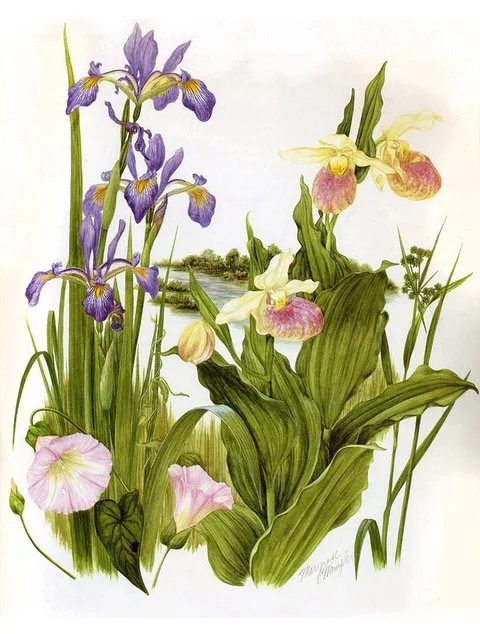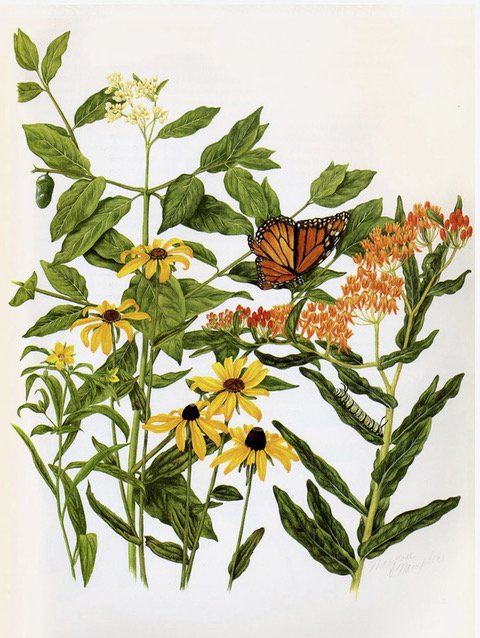By Suzanne Thorin
It’s three o’clock in the morning sometime in April in the 1970’s, and Maryrose Wampler is sleeping soundly in a tent somewhere in a state park in southern Indiana. She has an ax under her pillow, just in case. Fred, her husband and wildflower partner, has had to return to Bloomington because he is teaching the next morning. Maryrose and Fred have the least expensive accommodations, which consist of space for the tent, an open fire, and a toilet pit. At first Maryrose was nervous but she relaxed after she realized that the park was well patrolled.
Maryrose and Fred were hunting for wildflowers in Indiana state parks (with permission). She was the botanical artist and he wrote the texts. They were planning a huge coffee table book which was published by Indiana University Press in 1980 and was followed by Indiana Trees in 1988. Both are still available.
Maryrose died in 2017, but Fred still lives in the same house with any number of Maryrose’s paintings. It was my privilege to work with Fred, and during our conversations, to get to know Maryrose too.
She was a Bloomington celebrity for years, surpassing others such as Rocker John Mellencamp, violinist Joshua Bell, and the Kinsey Institute of Research in Sex. Her botanical paintings were everywhere, even in McDonald’s. She called herself a nature artist, and although she studied oil painting early on, she was a self-taught watercolor artist. Her obituary states that she developed “a watercolor technique that enabled unusual color intensity and detail.” In one of my interviews with Fred, he described her painting method as using “very little paint.”
She had to plan her outdoor painting schedule carefully. Sometimes several different plants had the same bloom season. She drew the subjects and then finished the painting on small areas of the drawing to establish color and texture and finished the entire painting later. As Fred writes in the Introduction to Indiana Wildflowers, “At the end of each painting season Maryrose’s portfolio was full of embryonic paintings that looked as if they had the measles.” The illustration boards were spotted with bits and pieces of flowers, stems, and leaves surrounded by notes scrawled in the margins. During the winter months she would work at home in her studio, filling in the rest of the paintings and adding the backgrounds.
Maryrose used only Winsor and Newton paints, illustration or art board (1/8 inches thick), and a variety of good brushes, all very small, according to Fred. She drew directly on the board and did not use tracing paper to transfer an initial drawing. After making a drawing that satisfied her, Maryrose’s next step was to apply a yellow tea-wash. She painted exclusively with transparent colors, and she used gouache to create highlights in leaves rather than allowing the illustration board to show through.
Maryrose painted from live subjects rather than photographs. Most of her paintings included habitat. Fred was charged to kill any butterflies, when she needed them, but when she wanted a rabbit, the little guy was put in a cage as she drew him. When released, he refused to leave their homestead, probably because of the robust meals he had been fed. Maryrose was a gourmet cook, and her recipe for shortbread with fresh rosemary is still famous in Bloomington.
Just one of Maryrose’s paintings is in the collections at the Hunt Institute for Botanical Documentation at Carnegie Mellon University in Pittsburgh, PA. Lugene Bruno, now retired from Carnegie, documented the painting for me, and a reproduction is found in Wildflowers of Indiana, Plate 35. Fred told me that they preferred to sell her paintings to give them income.
Their trips into the wild were arduous, but Maryrose was always ahead of Fred on the trail. Their frugal camping days came to an abrupt end, however, once their four children found out how primitive the camps were. They insisted that their parents move to camps of a higher level, which had plug-in electricity and actual showers and toilets. Still, Maryrose and Fred cherished their many trips without any such luxuries.
Creativity and energy fueled this couple throughout their lifetime partnership, and their complementary expertise made it possible to knit together each project. While Maryrose received much adulation during her life, fewer remember her now. Her work definitely deserves a second look.
Maryrose and Fred had a strong and loving partnership. They used their talents to create a rich life and left two magnificent books and more as a legacy for people like me to find and to learn about their contributions.
If anyone is interested in receiving a copy of the entire paper, please contact Suzanne via nesbanews@gmail.com.





